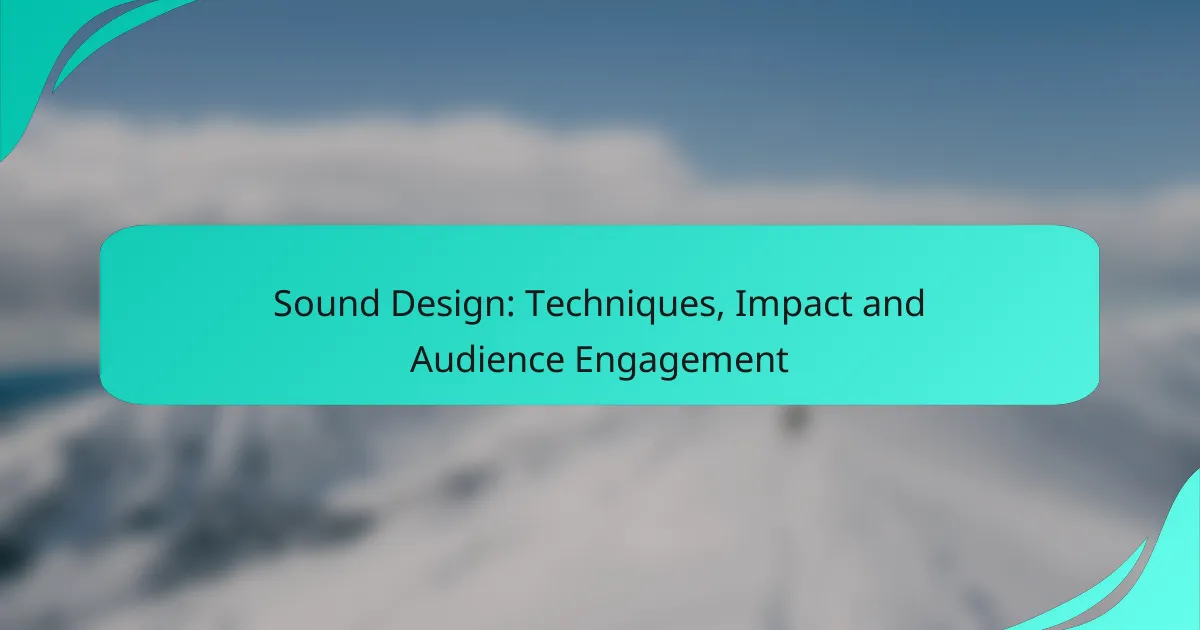Sound design plays a crucial role in enhancing audience engagement by creating immersive experiences that resonate emotionally. By employing techniques such as layering sounds, using Foley, and manipulating dynamic range, sound designers can effectively shape the narrative and deepen the connection between the audience and the story. The right tools, including Ableton Live and Pro Tools, further empower creators to craft compelling soundscapes that captivate listeners.
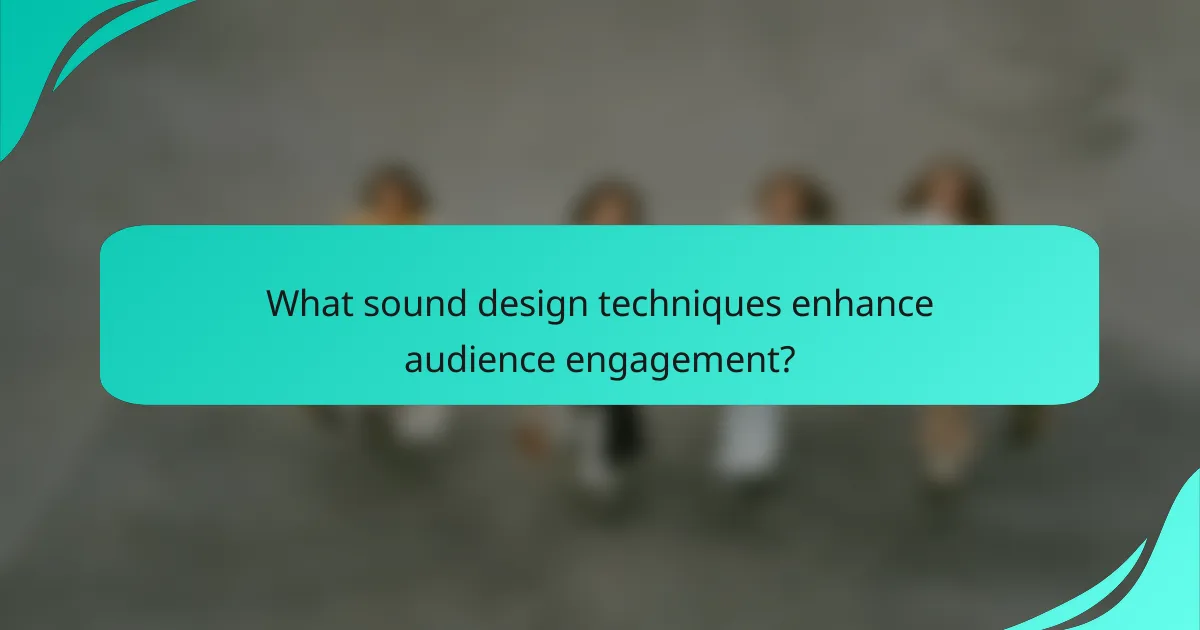
What sound design techniques enhance audience engagement?
Effective sound design techniques significantly enhance audience engagement by creating a more immersive and emotionally resonant experience. Techniques such as layering sounds, using Foley, manipulating dynamic range, employing spatial audio, and crafting soundscapes are essential in capturing and maintaining the audience’s attention.
Layering sounds for depth
Layering sounds involves combining multiple audio elements to create a richer and more complex auditory experience. This technique can include blending background music, sound effects, and dialogue to enhance the overall atmosphere. For instance, layering the sound of rain with distant thunder can evoke a more vivid sense of a stormy environment.
When layering, consider the frequency ranges of each sound to avoid muddiness. Use equalization to ensure that each layer is distinct yet harmonious. Aim for a balance where no single element overwhelms the others, allowing for a cohesive soundscape.
Using Foley for realism
Foley is the art of creating everyday sound effects that are added to films, videos, and other media to enhance realism. This technique involves recording sounds like footsteps, rustling clothes, or ambient noises that match the visuals. For example, the sound of a door creaking can significantly increase the tension in a suspenseful scene.
To effectively use Foley, ensure that the sounds are synchronized with the visuals. Pay attention to the context and environment; for instance, the sound of footsteps on gravel will differ from those on a wooden floor. High-quality recordings are crucial to maintain clarity and authenticity.
Dynamic range manipulation
Dynamic range manipulation involves adjusting the volume levels of audio elements to create contrast between the quietest and loudest sounds. This technique can heighten emotional impact, making key moments more striking. For example, a sudden loud sound can jolt the audience’s attention after a period of silence.
When manipulating dynamic range, be cautious not to over-compress audio, as this can lead to listener fatigue. Aim for a dynamic range that feels natural and supports the narrative. A good practice is to maintain a range of at least 10-15 dB between quiet and loud passages for optimal engagement.
Spatial audio techniques
Spatial audio techniques create a three-dimensional sound environment, allowing audiences to perceive sound as coming from different directions. This can be achieved through stereo, surround sound, or more advanced formats like Dolby Atmos. For instance, placing sound effects in specific locations can make a scene feel more immersive.
To implement spatial audio effectively, consider the listener’s perspective and the placement of sounds in relation to the visuals. Use panning and volume adjustments to simulate movement and depth. Testing in various listening environments can help ensure a consistent experience across different playback systems.
Soundscapes for immersion
Soundscapes are designed audio environments that immerse the audience in a specific setting or mood. They can include a combination of natural sounds, music, and effects that transport listeners to a different place. For example, a forest soundscape might feature birds chirping, leaves rustling, and a distant stream.
When creating soundscapes, focus on layering various elements to build a rich auditory tapestry. Consider the emotional tone you want to convey and select sounds that enhance that feeling. Regularly revisiting and refining your soundscape can help maintain its effectiveness and relevance to the narrative.
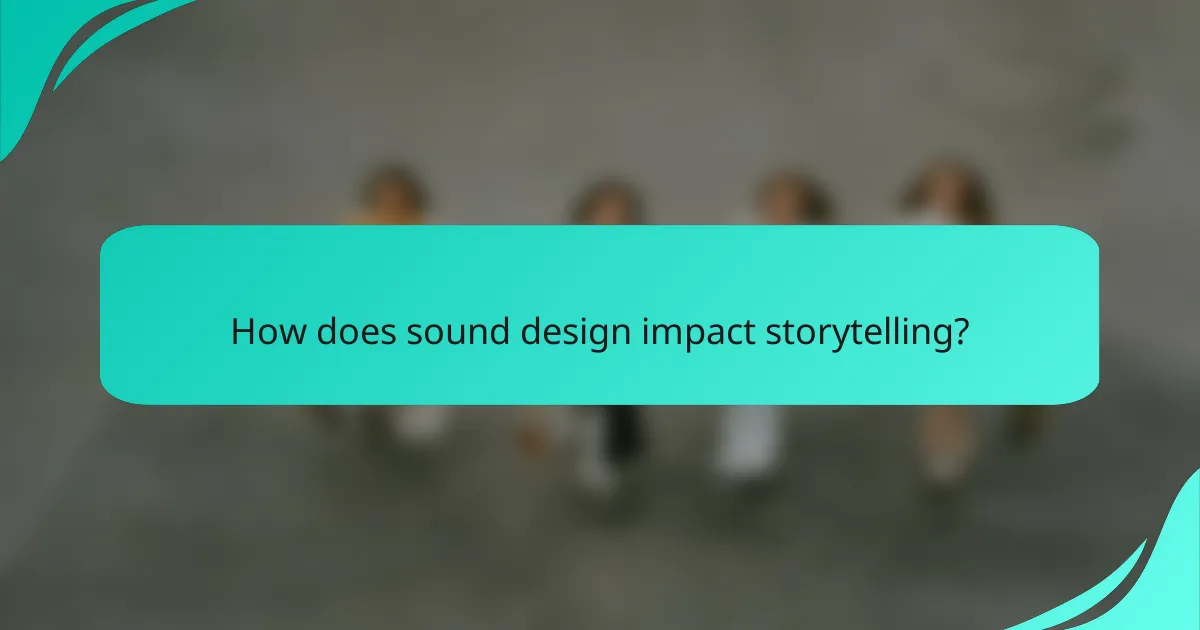
How does sound design impact storytelling?
Sound design significantly enhances storytelling by shaping the audience’s emotional experience and guiding their perception of the narrative. Through the strategic use of music, sound effects, and audio cues, sound design creates an immersive environment that deepens engagement and connection with the characters and plot.
Emotional resonance through music
Music plays a crucial role in evoking emotions and setting the tone for a narrative. By selecting specific genres, tempos, and harmonies, sound designers can influence how the audience feels during key moments. For instance, a slow, melancholic score can heighten feelings of sadness, while an upbeat track can create a sense of joy or excitement.
When integrating music, consider the context and character arcs. Themes associated with particular characters can reinforce their emotional journeys, making the audience more invested in their outcomes. Using motifs effectively can create a powerful emotional resonance that lingers long after the story ends.
Creating tension with sound effects
Sound effects are essential for building tension and suspense in storytelling. Subtle sounds, like creaking doors or distant thunder, can create an atmosphere of unease, while sudden loud noises can startle the audience and heighten anxiety. Effective sound design uses these elements to manipulate pacing and anticipation.
To create tension, consider layering sounds to build complexity. For example, combining a low rumble with high-pitched tones can create a sense of impending danger. Additionally, silence can be just as powerful; moments of quiet can amplify the impact of subsequent sounds, making the audience more alert and engaged.
Character development via audio cues
Audio cues can provide insight into a character’s personality and emotional state, enhancing character development. Unique sound signatures, such as a specific musical instrument or sound effect, can be associated with particular characters, helping to establish their identity and presence in the story.
Using audio cues consistently throughout a narrative can reinforce character traits and arcs. For example, a character who is anxious might be accompanied by dissonant sounds, while a heroic figure may have uplifting musical themes. This auditory branding helps the audience form connections and understand character motivations more deeply.
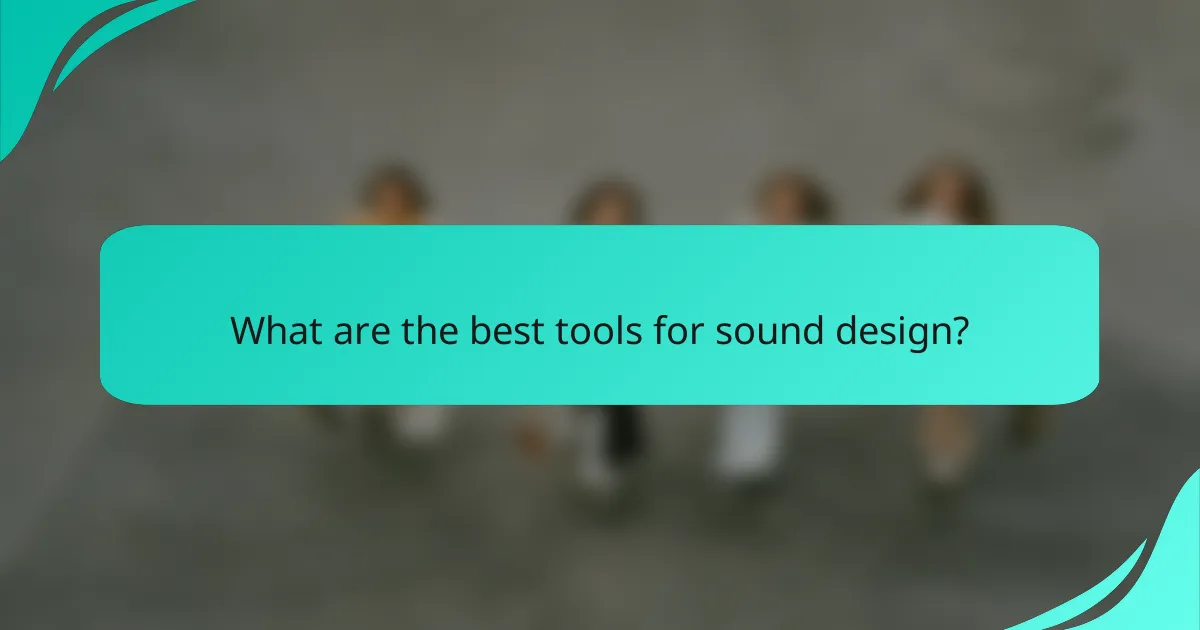
What are the best tools for sound design?
The best tools for sound design vary based on the specific needs of the project, but popular choices include Ableton Live, Pro Tools, and Adobe Audition. Each of these applications offers unique features that cater to different aspects of sound production, editing, and post-production.
Ableton Live for music production
Ableton Live is a versatile digital audio workstation (DAW) favored by musicians and sound designers for its intuitive interface and powerful capabilities. It excels in live performance settings and offers a range of tools for composing, recording, and mixing music.
Its Session View allows for flexible arrangement and experimentation, making it ideal for electronic music production. Users can easily manipulate audio clips, apply effects, and integrate MIDI instruments, which enhances creativity and workflow.
Pro Tools for editing
Pro Tools is considered the industry standard for audio editing and mixing, widely used in studios for film, music, and broadcast. It provides advanced editing features, including precise waveform manipulation and multi-track recording, which are essential for professional sound design.
Its robust capabilities allow sound designers to work with high track counts and complex projects. However, it may require a steeper learning curve and a more powerful computer setup compared to other DAWs, making it crucial to assess your needs before investing.
Adobe Audition for post-production
Adobe Audition is a comprehensive audio editing software that excels in post-production tasks such as sound restoration and mixing. It offers a user-friendly interface and powerful tools for cleaning up audio, making it a popular choice for filmmakers and podcasters.
Key features include spectral frequency display and noise reduction tools, which help enhance audio quality. Its integration with other Adobe Creative Cloud applications allows for seamless workflows, particularly for projects involving video editing.
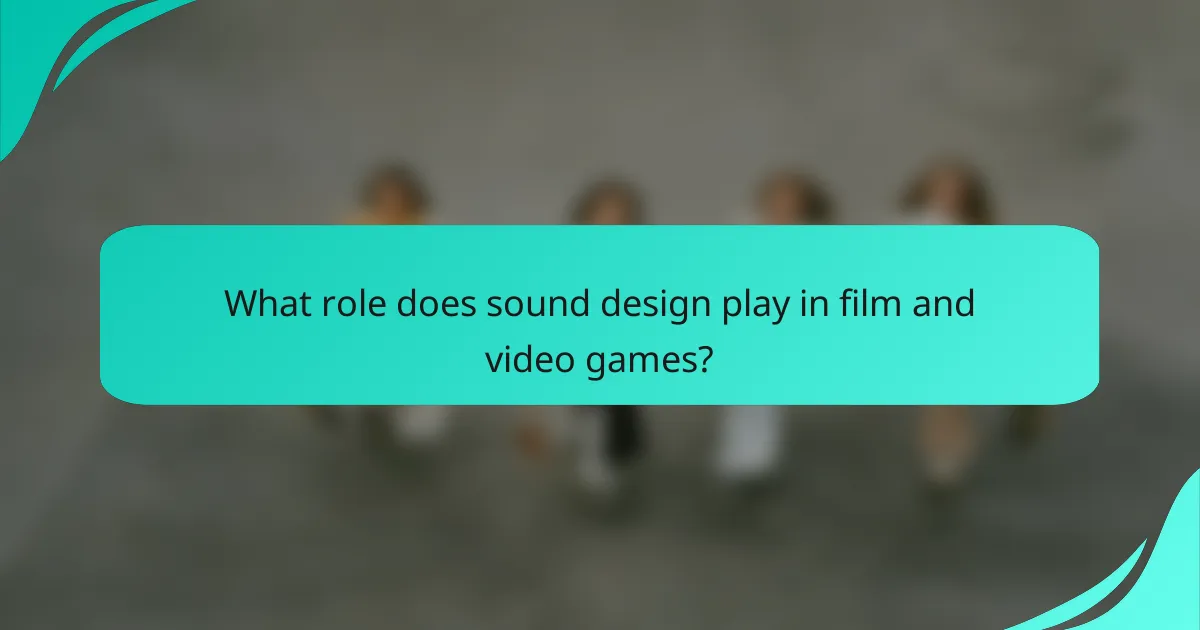
What role does sound design play in film and video games?
Sound design is crucial in both film and video games as it shapes the overall experience by enhancing storytelling and creating immersive environments. It involves the careful selection and manipulation of audio elements to evoke emotions and engage audiences effectively.
Enhancing narrative in film
In film, sound design supports the narrative by reinforcing themes and character emotions. For example, a suspenseful score can heighten tension during critical scenes, while ambient sounds can establish the setting and mood.
Key techniques include the use of diegetic sounds, which are sounds that originate from the film’s world, and non-diegetic sounds, such as background music. Both types can be strategically layered to create a richer storytelling experience.
Immersion in video games
In video games, sound design plays a vital role in creating an immersive experience that draws players into the game world. Effective sound design can enhance gameplay by providing audio cues that inform players about their environment or actions, such as footsteps indicating nearby enemies.
Consider using spatial audio techniques to create a three-dimensional soundscape, allowing players to perceive direction and distance. Additionally, adaptive soundtracks that change based on player actions can significantly increase engagement and emotional investment.
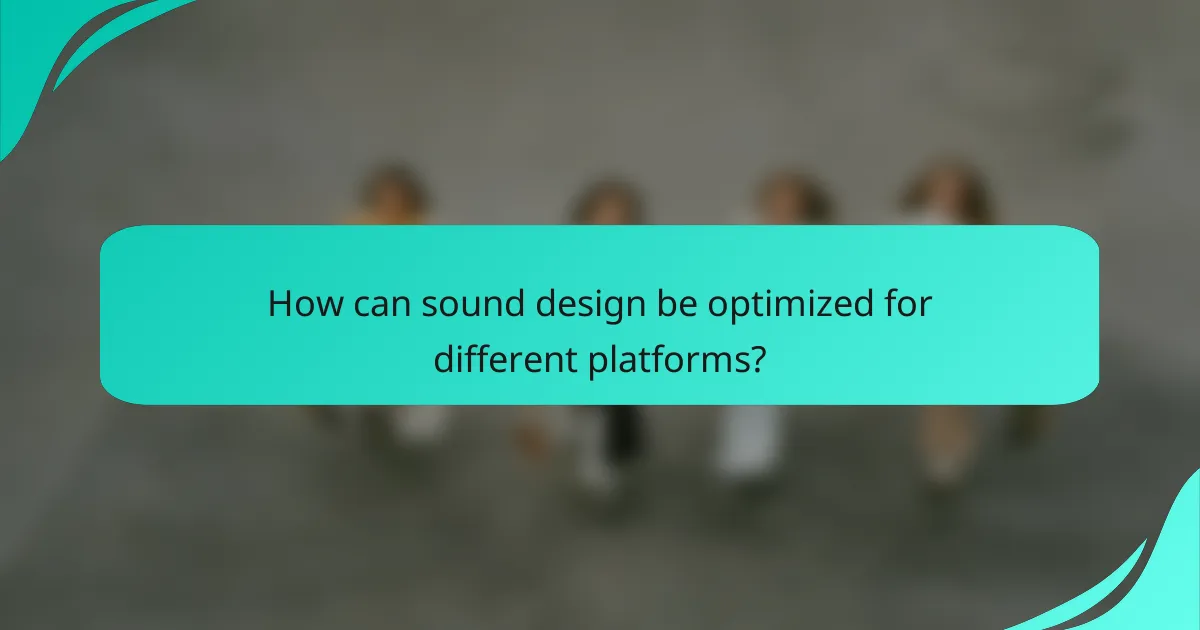
How can sound design be optimized for different platforms?
Sound design can be optimized for different platforms by tailoring audio elements to fit the unique characteristics and limitations of each medium. This includes considerations for device capabilities, user environments, and audience expectations.
Adapting audio for mobile devices
When designing sound for mobile devices, focus on clarity and brevity. Mobile users often listen in noisy environments, so prioritize distinct sounds that cut through background noise. Use formats like AAC or MP3 for efficient compression without significant quality loss.
Consider the limitations of smaller speakers; bass frequencies may not translate well. Aim for a balanced mix that emphasizes mid and high frequencies to ensure audio remains intelligible. Testing on various devices can help identify how sound translates across different models.
Optimizing sound for VR experiences
In virtual reality (VR), sound design plays a crucial role in immersion. Use spatial audio techniques to create a 3D sound environment that responds to user movements. This enhances realism and helps users orient themselves within the virtual space.
Implement binaural audio techniques to simulate how sound is perceived in real life. This requires careful placement of audio sources and consideration of how sound waves interact with the virtual environment. Always test audio in the VR setting to ensure it aligns with visual elements and enhances the overall experience.
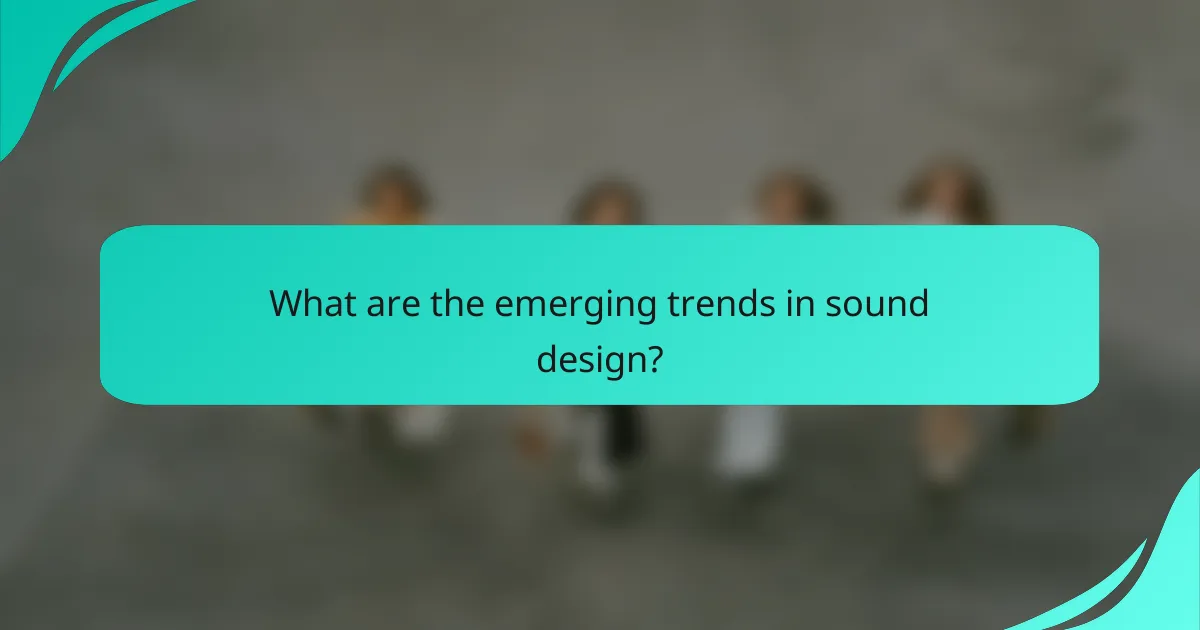
What are the emerging trends in sound design?
Emerging trends in sound design focus on innovative technologies and immersive experiences that enhance audience engagement. Key developments include AI-driven sound generation, interactive soundscapes in installations, and the use of 3D audio in streaming services.
AI-driven sound generation
AI-driven sound generation utilizes algorithms to create music and sound effects, allowing for rapid production and customization. This technology can analyze existing audio to generate new compositions that fit specific moods or themes, making it a valuable tool for filmmakers and game developers.
When using AI for sound design, consider the balance between human creativity and algorithmic output. While AI can produce unique sounds, it may lack the emotional depth that a human touch provides. Experimenting with AI tools can lead to innovative results, but always review and refine the output to ensure it aligns with your vision.
Interactive soundscapes in installations
Interactive soundscapes create immersive environments where sound responds to audience movements or actions. These installations often use sensors and software to adjust audio elements in real-time, enhancing the overall experience and engagement.
To design an effective interactive soundscape, focus on the relationship between sound and space. Consider how different sounds can evoke emotions or memories, and use layering techniques to create depth. Testing the installation with real users can provide insights into how they interact with the sound, allowing for adjustments that improve engagement.
3D audio in streaming services
3D audio is becoming increasingly popular in streaming services, providing an immersive listening experience that simulates sound coming from various directions. This technology enhances music, podcasts, and films, making them more engaging for the audience.
When implementing 3D audio, ensure compatibility with various playback devices, as not all headphones or speakers support this format. Consider using binaural recording techniques or spatial audio software to create a rich sound environment. Keep in mind that while 3D audio can elevate content, it should complement the narrative rather than distract from it.
